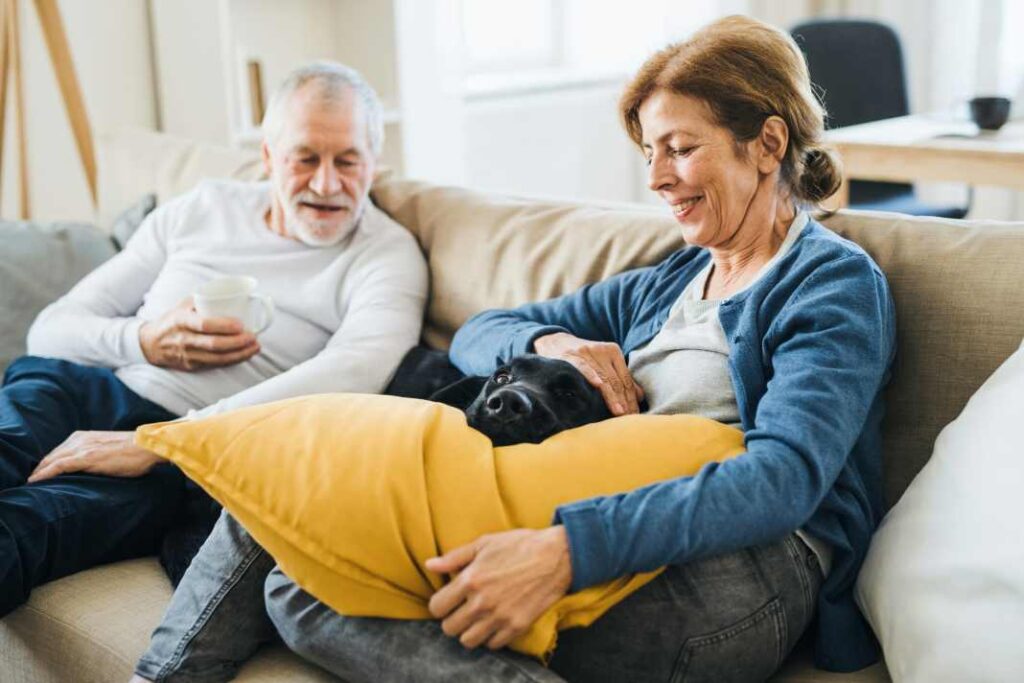Creating a Calming Environment for Dogs: In this article you will learn essential strategies for reducing anxiety and improving their behavior by creating a stress-free environment tailored to their individual needs.
As an Amazon Associate, I earn from qualifying purchases. When you purchase products through the links on this page, I may earn a small commission at no extra cost to you.
Significance of Essential Strategies for Reducing Anxiety for Your Dog
Creating a serene and stress-free living space for our dogs is not just about comfort, but it’s essential for their health and well-being. Like humans, dogs can experience stress and anxiety, which can manifest in various forms and adversely affect their behavior and overall quality of life. By understanding and catering to their specific needs and triggers, dog owners can craft an environment that promotes calmness and security for their furry friends.
This deliberate effort to create a calming environment is crucial not only for mitigating dog anxiety but also for fostering a stronger, more harmonious relationship between dogs and their owners. A dog that feels safe and relaxed is more likely to display positive behaviors, making the household a happier place for everyone involved.

The Science Behind Dog Stress and Calmness
The impact of stress on dogs extends beyond mere behavioral issues; it can significantly affect their physical health, making them more susceptible to illnesses. Conversely, a calming environment triggers the release of stress-reducing hormones such as oxytocin, contributing to their relaxation and contentment.
For example, a study observed that dogs in a calm setting exhibited lower heart rates and displayed signs of relaxation, such as lying down and sleeping, more frequently than those in a stressful environment.
Furthermore, recognizing behavioral changes in dogs, such as excessive grooming in cats or aggression in dogs, can be indicators of underlying stress. Addressing these signs by adjusting the environment to reduce stressors can lead to improved behaviors and a happier dog.

Designing a Relaxing Physical Space for Dogs
A relaxing physical space for dogs involves more than just a quiet corner; it encompasses a range of sensory experiences designed to soothe and comfort. A soft, plush bed in a quiet part of the house can serve as a safe haven for dogs and cats alike, offering them a secure retreat during loud events or when they’re feeling overwhelmed.
Introducing calming scents like lavender through diffusers can also contribute to a multi-dimensional calming environment, enhancing the soothing effect for dogs.
Moreover, the arrangement of the physical space can significantly influence a dog’s sense of security. For instance, providing cats with elevated perches allows them to observe their surroundings from a safe vantage point, reducing their stress levels and promoting a sense of calm.
Implementing Effective Calming Techniques and Routines
Consistency in daily routines plays a pivotal role in creating a peaceful dog space. Dogs thrive on predictability; knowing when to expect their next meal or walk can significantly reduce anxiety and provide a sense of security. Additionally, engaging dogs in mental stimulation activities like puzzle toys or interactive games can prevent boredom and contribute to a stress-free environment.
Positive reinforcement training is another powerful tool in promoting calm behaviors. Rewarding dogs for displaying calmness can reinforce these behaviors, further embedding a peaceful atmosphere within the home.
Utilizing Calming Products and Aids
The market offers a variety of calming aids designed to reduce anxiety and promote relaxation in dogs. Pheromone diffusers and calming collars are among the recommendations for easing dog stress, mimicking the natural pheromones to soothe and comfort animals. Supplements featuring natural ingredients such as chamomile or CBD (Hemp Oil for Dogs) can also support emotional well-being and aid in stress management.
Incorporating calming products into regular activities, like gentle grooming sessions with a lavender-scented shampoo, can enhance the relaxation response, making these moments an additional source of comfort for dogs.
Creating a Multi-Sensory Soothing Environment
Creating a calming environment for dogs involves engaging all their senses. Aromatherapy options such as eucalyptus and chamomile can have a significant calming effect on animals, helping to soothe and relax them. Visual stimuli, too, play a crucial role; soft, calming colors in the dog’s living space can create a serene atmosphere that promotes relaxation.
Auditory cues are equally important. Playing classical music or using white noise machines can help mask disruptive outside noises, creating a peaceful auditory environment that further encourages relaxation in dogs.
Addressing Specific Needs of Dogs and Cats
Catering to the specific needs of dogs and cats is essential in creating a calming environment. Dogs, for instance, benefit from structured routines that include daily walks and playtime, which not only help in maintaining their physical well-being but also in reducing anxiety. For cats, providing hiding spots and elevated perches in a multi-pet household can create a sense of security and reduce stress.
Understanding the unique body language and communication cues of pets is vital in recognizing signs of stress. This knowledge allows dog owners to adapt the environment accordingly, promoting a sense of calm and well-being.

Conclusion: Positive Impact of a Calming Environment on Dogs and Owners
The benefits of establishing a calming environment extend beyond the immediate comfort it provides to dogs. It fosters a deeper bond between dogs and their owners, leading to a more harmonious and joyful household. By implementing the strategies outlined to create a stress-free environment, dog owners can witness a noticeable improvement in their dogs’ behavior, health, and overall well-being.
Helping Your Pup Weather the Storm: Effective Strategies for Coping with Dog Anxiety During Thunderstorms

A comprehensive guide on coping with dog anxiety during thunderstorms, including understanding the signs of anxiety, creating a safe space, using calming products, desensitization training, seeking professional help, and the importance of owner behavior.
Continue reading: Effective Strategies for Coping with Dog Anxiety During Thunderstorms




